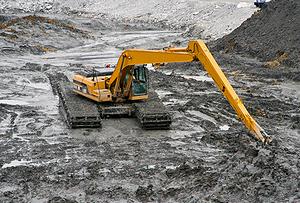EPA Orders Utilities to Self-Report Coal Ash Impoundment Problems
WASHINGTON, DC, March 9, 2009 (ENS) - Responding to the coal ash spill last December at a Tennessee Valley Authority power plant in Kingston, Tennessee, the U.S. Environmental Protection Agency today released a plan intended to prevent threats to human health and the environment from similar incidents.
The EPA plans to gather coal ash impoundment information from electric utilities nationwide, conduct on-site assessments to determine structural integrity and vulnerabilities, order cleanup and repairs where needed, and develop new regulations for future safety.
The EPA estimates there may be as many as 300 coal ash impoundments across the United States.
"Environmental disasters like the one last December in Kingston should never happen anywhere in this country," said EPA Administrator Lisa Jackson. "That is why we are announcing several actions to help us properly protect the families who live near these facilities and the places where they live, work, play and learn."
Early on the morning of December 22, 2008, a retaining wall gave way at the coal-fired Kingston Fossil power plant about 35 miles west of Knoxville, at the junction of the Emory and Clinch Rivers.
Release of more than a billion gallons of sludgy wet coal ash flooded nearly 400 acres of land, damaging homes and property, ruptured a major gas line in a neighborhood adjacent to the plant and damaged a railway line.
The EPA estimates that over five million cubic feet of fly ash and water were released onto land adjacent to the plant and into the nearby Clinch and Emory rivers, filling large areas of the rivers and killing fish.
 |
One of dozens of wide-track earth movers struggles to control the coal ash sludge from the Kington ash spill. (Photo courtesy TVA) |
Cost estimates for the cleanup range between $525 million and $825 million, which does not include long-term cleanup costs, according to the TVA, a federal government agency.
In letters today, EPA requested that electric utilities with surface coal ash impoundments or similar units provide information about the structural integrity of their facilities. The federal agency is asking for information about diked or bermed facilities that contain "by-products from the combustion of coal, including but not limited to, fly ash, bottom ash, boiler slag, or flue gas emission control residuals."
These information requests are legally enforceable and must be responded to fully within 10 days, Jackson said in the letter of request.
Working closely with other federal agencies and the states, EPA will review the information provided by the facilities to identify impoundments or similar units that need priority attention. EPA also will visit many of these facilities to see first hand if the management units are structurally sound.
The agency will require appropriate remedial action at any facility that is found to pose a risk for potential failure.
The assessment and analysis of all such units located at electric utilities will be compiled in a report and made available to the public.
EPA is also developing regulations to address the management of coal combustion residuals. Jackson said the agency anticipates having a proposed rule ready for public comment by the end of the year.
The Tennessee Valley Authority last week submitted to state and federal agencies its corrective action plan for cleaning up the surrounding lands and waters following the coal ash spill at the Kingston Fossil Plant.
This plan proposes how TVA will remove ash from the Emory River channel and store it temporarily at the Kingston plant site until a final disposal plan has been developed and approved. Removing the ash from the channel will help reduce flood risk, improve water quality, and mitigate impacts to aquatic life, the TVA says.
The plan also includes measures to control upstream flooding along the Emory River and to continue to accommodate recreational use of the river system.
TVA's plan must now be approved by the U.S. EPA and the Tennessee Department of Environment and Conservation.
Copyright Environment News Service (ENS) 2009. All rights reserved.
To subscribe or visit go to: http://www.ens-newswire.com